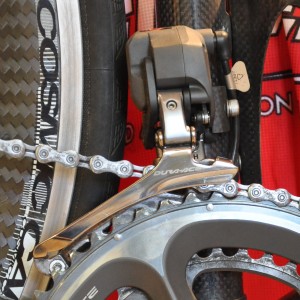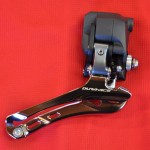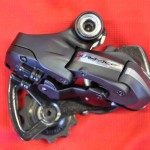Shimano 7970 Di2
 Shimano Di2 Electronic Shifting
Shimano Di2 Electronic Shifting
(Digital Integrated Intelligence)
By Geoff Hull
Fitter and Product Consultant Fit Werx, MA
While Shimano was not the first company to attempt an electronic drivetrain, Di2 is the first to prove just how good the concept is.
Before I get started on Shimano’s electronics, let’s take a quick look at how we got here. In 1974 Bruce W. Browning of the Browning gun MFG company began designing an automatic drive system for bicycles. This system involved hinged plates on the chain rings that would smoothly deliver the chain to the next ring in combination with a four speed rear cassette. In 1980 a two speed BMX transmission was adapted and by the late ‘80’s a three speed system for ATB use was licensed to SunTour under the name “BEAST” (Browning Electronic AccuShift Transmission). From the two buttons on the center of the handlebar, you could shift it up or down. Sadly, this worked better in the show room than in real world riding – it was not fond of rain. SunTour fell on hard times shortly after and terminated the system’s development, however, Browning continued development and by 1993 had an automatic electric drive system that operated on a 9 volt battery that would last 200-300 miles. This system was intelligent and would automatically shift gears to maintain your cadence. If the system was not in sync with how you were feeling on a given day you could reset it to a new cadence and it would learn that. Browning also created a four button system that allowed the rider to choose gears both up and down on the front and rear of the bike which allowed the user to manually control the system and the shifting or use the “auto pilot” mode. Mavic developed electronic shifting with two different evolutions in the early 90’s, first with the Zap system, which was a wired system, and later the wireless Mektronic system. Both had limited success due to a few issues. One problem was that society wasn’t ready for it at the time, but the other, and bigger, reason was that it was not very reliable and was mechanically finicky. The Mavic rear derailleur was unable to pick up chain slack quick enough due to an antiquated design that used an internal rod and servo system instead of the standard slant parallelogram derailleur design we have grown accustomed to – the result was derailleur stiction and sometimes inoperable or unpredictable shifting. Chris Boardman won the Tour De France prologue in 1994 using the Zap shifting system, but he stopped using it soon after because it would shift unpredictably. Campagnolo has been researching and developing an electronic system since 2003 and they are slated to release as system in 2012. We’ll see what they have been working on this racing season if the components on a certain Spanish racing team are any evidence.
I digress, back to Shimano…
Di2 will quite simply change the way you ride – period. I’ve had the pleasure of riding Di2 over the past year and it does all it says and then some. The primary advantages of the system that I have recognized:
- Precision and Shifting Under Load – Have you ever missed your opportunity to shift while climbing a steep hill out of fear that you would lose the chain or because the bike simply would not shift under that type of load? With Di2, this issue is eliminated. If you want to shift into the big ring under huge load, it will do it. If you want to shift from the big ring to the small under full load, it will do it. Di2 shifts without question each and every time, even under loads you would normally never think of trying to shift under with a cable actuated system. The rear derailleur shifting is equally precise. Those of us that come from a mountain bike background are very familiar with having to unweight the system as you pedal to assist the shifting process, with Di2, by the time you unweight, the shift has already taken place. The derailleur is designed to slightly over-shift to guarantee a quick and precise shift before it centers on the cog of choice to reduce noise and friction.

- Low Maintenance – No cables means no friction and no friction means great shift quality with nothing to gum up or fail. The derailleurs almost set themselves on Di2 and there are no cables to fray, break or replace. Get on it, ride, repeat.
- Self Adjusting Front Derailleur – A nice touch that Shimano’s engineers designed into Di2 is a front derailleur that adapts to what gear is being used on the rear cassette; the front derailleur automatically adjusts to prevent the chain from rubbing the front derailleur, allowing you to use the full range of the rear cassette without further thought or noise. The front derailleur knows where the rear derailleur is at all times and makes micro adjustments accordingly – pretty slick.
- Low Energy/No Wrist Motion Shifting – With Di2 on a road bike, the shifting controls are at the brake levers, in a similar location to any standard Shimano STI system. However, instead of a sweeping wrist activated lever there are soft touch contact buttons. These shifts take only 2mm of finger movement to actuate and require very little thought or effort. Ease of shifting results in more efficient pedaling for most riders as you won’t hesitate to change gears at a given moment as it so effortless.
- Optional Remote Shifting – In addition to the usual hoods position, remote buttons to shift the rear derailleur can be installed in two locations – for climbers, on the top of the bars close to the stem and, for the sprinter, a set of buttons can be installed on the drop under the lever. Mark Cavendish successfully used the drop placement in the Tour Down Under.
Di2 works really well on a road bike, but is ideally suited for a TT/Tri bike. For TT, the rider has two shift position options that can be used independently or jointly. 1) On the aerobar extensions, in a similar position to a cable shifter, there are contacts for both derailleurs. 2) On the base bar combined with the brake levers for riders who would like to be able to shift while climbing or sprinting without reaching for the extensions. In an event where every second counts, advantages like these are tangible and count in the form of saved time.
Road or aero, riders almost immediately notice that they hesitate less and shift more frequently with Di2 as shifting is so smooth and can be done regardless of load or riding conditions. Also, with the optional shifters, you can shift from any number of other positions on the handlebar.
Dura Ace System Components:
Di2 is the electronic version of Shimano’s 7900 Dura Ace group and is designed to work best with a complete selection of Dura Ace 7900 components. While Shimano is not winning the weight war, Dura Ace comes in about 100 grams heavier than Campy’s Super Record group and 200 grams heavier than SRAM’s Red group, Di2 is only 68 grams – the weight of the battery – heavier than a standard 7900 group. This is a pretty negligible weight difference for all that Shimano Di2 offers in performance.
Let’s break down some of the individual components that make up the Dura Ace 7900 group:
Brakes – Who likes to be able to stop? The 7900 brake set is 30 grams lighter than the 7800 series it replaced and the brakes have increased braking power due to an enhanced leverage arm. For best results, you want to use 7900 calipers and levers together as they work off a unique leverage ratio designed into the system.
Cranks – With hollow alloy arms and chainrings, the 7900 crankset is truly a piece of engineered art. Like any piece of art, you may or may not like the way it looks, but it is hard to deny how well it works. The large ring on either the compact or standard cranks is made of two pieces of aluminum bonded together to make a very light and extremely stiff hollow chainring. The shifting ramps are improved to grab the newly designed unidirectional chain. At 674 grams it may only be 15 grams lighter than its predecessor, but it is also 20% stiffer than the 7800 – an impressive accomplishment.
Chain – The chain is designed asymmetrically to improve both upshifts and downshifts on the chain rings and is specifically designed for use on road bikes (Shimano makes MTB specific chains now too). The pins on the 7901 chain are hollow and the side plates have cutouts to reduce weight down to 263 grams. Shimano tried the first edition of these chains with a master link, but the link stretched and caused poor shifting and thus they have since returned to the HG connector pin that has been a mainstay of their chains for decades now.
Cassette – At 166 grams, the 7900 cassette is 10 grams lighter than the 7800, a negligible amount. However, weight is not what makes the new 7900 cassette better. The new aluminum carrier is stiffer and the ramps of the rings have been redesigned to work in concert with the asymmetrical pattern of the 7900 chain. These changes noticeably improve power transfer during shifting and fluidity with the drive train and, when coupled with Di2 shifting, the result is the smoothest shifting on the market.
Shift Levers – A standard mechanical 7900 lever set weighs 367 grams and the Di2 levers come in at 258 grams – this is where electronics same some notable grams. The Di2 lever is completely redesigned and, without the need to consider cable routing and functionality, Shimano was able to slim the lever for a more ergonomic fit and long distance comfort. The brake lever can also be fine tuned to fit the rider’s reach with a set screw in the lever.
 Front Derailleur – The 7900 front derailleur is 66 grams whereas the Di2 is 121 grams and shifting is accomplished by the power of a CPU controlling the worm drive driven unit in the derailleur. There is a slight over-shift that re-centers so quickly that you may miss it with your eyes. The derailleur is so powerful and fast that when shifting under load you may have to look to believe it’s shifted – it is phenomenally quick and accurate.
Front Derailleur – The 7900 front derailleur is 66 grams whereas the Di2 is 121 grams and shifting is accomplished by the power of a CPU controlling the worm drive driven unit in the derailleur. There is a slight over-shift that re-centers so quickly that you may miss it with your eyes. The derailleur is so powerful and fast that when shifting under load you may have to look to believe it’s shifted – it is phenomenally quick and accurate.
Rear Derailleur – Because of the motor, the Di2 rear derailleur is heavier at 222 grams than the standard 7900 rear derailleur at 165 grams. Like the front derailleur, the Di2 rear derailleur uses a worm drive and shifting is accomplished by slightly over shifting in either direction and then re-centering.
One concern with Di2 is that the $900 rear derailleur is a big deal to replace in the event of a crash. Shimano engineers realized this and, should the bike crash and strike the rear derailleur, it disengages the worm drive and moves inbound towards the wheel to protect itself. When the system is put under load again, after a few shifts it resets. Should the crash be bad enough that the automatic alignment does not reset to your liking, you can use the system adjustment buttons on the fly to adjust the shifting. This adjustment only takes seconds when practiced and it is actually easier than a standard cable adjustment.
Wiring Harnesses – The wires that connect the derailleurs to the shifters complete the system. Currently, frame manufacturers are designing frames to accommodate two common routings for electronic harnessing – internal and external. Internal wiring uses a special heat shrink tubing over the connections to make it waterproof and routes the cabling inside the actual frame tubing via connectors while the external system is waterproof by the snap connections at each unit. Two wiring harnesses are required, an upper that connects the shifter to the adjuster and a lower that completes the circuit with the derailleurs and battery. The rear harness comes in three sizes and the installer will need to make a few measurements to assure the correct length. In our experience, medium works well for most everything but the largest and smallest frames. Wiring harnesses are also available in internal and externally routed designs.
The Battery – The battery can be charged anytime the rider wishes as there is no charge memory to reduce the length of battery life. Charging every 600 – 1000 miles at a life of around 300 charges will get you over five years of life. The battery has a bracket that can be attached to the water bottle mounts and, in some cases this means the loss of a water bottle. For this reason, some frame manufacturers are installing two screw mounts under the non-drive chain stay to cleanly attach the battery with an aftermarket short bracket.
Di2 Concerns: When I talk to people about Di2 they bring up two primary concerns:
1) Battery Failure – What happens should the battery fade while on a ride? Shimano claims over 1,000 miles of use between charges and I charged my battery only four times this year. Each charge takes only 90 minutes and I never saw the indicator light on the control unit tell me the battery was getting low and even if it did flash, I would have had time to finish out my ride with the system functioning fine regardless. The batteries have proven highly reliable and I am not concerned about it at all any longer.
2) Cost – Di2 is not cheap. But, what are you paying for? The answer is simple – purely the best shifting performance on the market. You will never miss a shift again and you will shift in ways you never thought possible before.
Are there other potential downsides?
I can’t think of any. I guess it could be argued that many shops still don’t have much experience with it and thus may not be able to service it as well as possible because they haven’t worked on it much. If you are traveling with your bike you may want to see if there are shops in the area that can work on the system and have parts should an issue arise.
None of the Di2 systems that we’ve delivered have had to come back for derailleur adjustments; once the derailleurs are set they will not come out of alignment. With Di2, there are no cables to stretch, no cable housings to break down, split, or create drag and poor shifting. Once you’ve ridden this system, crested a hill, jumped out of a pack, bridged a gap, or simply enjoyed an afternoon  or weekend ride you will realize that it is not gimmicky and was worth the investment.
or weekend ride you will realize that it is not gimmicky and was worth the investment.
Di2 will quite simply, change the way you ride. Yes, I like it and I don’t hesitate to recommend it.


